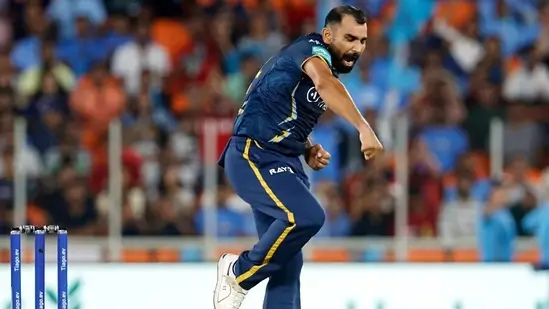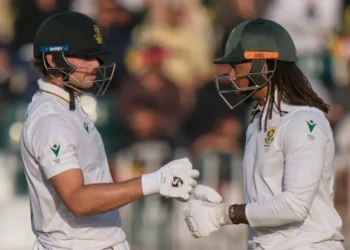Mohammed Shami remains one of India’s most skilled fast bowlers. His absence from the national team has created fresh debate among fans and experts. The Rock and Roll It Podcast on ESPNcricinfo recently explored whether Shami is unlucky or underrated, discussing his impact, statistics, and future. The conversation examined why such a proven match-winner has been sidelined despite his consistent record.
Hosts Dustin Silgardo, Sidharth Monga, and Karthik Krishnaswamy unpacked Shami’s bowling craft, his fitness, and his potential to return. They debated if India’s current selection focus on younger bowlers has worked against him. Shami, who last played in the Champions Trophy earlier this year, continues to train and stay match-ready. His skill, rhythm, and experience still make him an asset for any Indian lineup.
Is Shami being overlooked or just unlucky?
Shami’s exclusion raises fair questions about India’s selection process and fast-bowling depth. In recent years, the management has rotated bowlers based on workload and form. While that strategy protects players, it also sidelines experienced performers like Shami. The competition from Bumrah, Siraj, and Prasidh Krishna has also made team spots scarce.
The podcast highlighted how selectors now value all-format availability and fresh fitness data. Shami, having faced injury spells in the past, might be viewed as a short-term option. Yet his record shows remarkable consistency even after lay-offs. His strike rate and average across Tests and ODIs remain among the best in India’s pace history.
Panelists argued that Shami’s absence is not due to a decline in skill. Instead, timing, perception, and selection philosophy play major roles. When new players emerge and perform, veterans often get limited chances regardless of form. Shami’s case reflects the cost of rotation culture in modern cricket.
The skill set that makes Shami special
Few bowlers in India’s history have matched Shami’s natural seam control. He extracts movement off the pitch with perfect wrist position and balance. His late swing with the old ball makes him deadly in both directions. The reverse swing he generates on abrasive surfaces remains among the best in the game.
Shami’s accuracy allows captains to use him in short, attacking bursts. He builds pressure through relentless consistency, forcing errors from set batters. Even in the IPL, his economy against top-order hitters remains impressive. That adaptability separates him from other fast bowlers in the current pool.
Statistically, Shami averages below 28 in Tests and around 26 in ODIs. Those numbers stand strong even when compared with global stars like Rabada and Cummins. He also picks wickets in clusters — a rare quality that turns matches quickly. His blend of rhythm, aggression, and calm makes him a genuine match-winner for India.
What the podcast reveals about Shami’s reputation?
The podcast goes beyond numbers to explain how narrative shapes selection. Many fans assume Shami is injury-prone or aging, but the data disagrees. His pace still touches 140+, and his control is unmatched among Indian quicks. Yet, selectors sometimes lean toward younger options for long-term planning.
The hosts emphasized how media framing can affect perception. When discussions focus on new talents, veterans like Shami fade from spotlight. That shift in attention impacts how selectors and fans perceive form. As one panelist noted, “Shami has not declined — he’s just out of sight.”
The conversation urged selectors to view data and experience with balance. A player’s age shouldn’t overshadow consistent wicket-taking numbers. With proper communication and clarity, India could use Shami’s expertise to mentor and perform simultaneously.
What Shami needs for a comeback?
For Shami to return, timing and visibility are crucial. Strong domestic performances can quickly change selectors’ mindset. If he dominates in red-ball games or IPL seasons, public and media pressure will follow. Selectors often reconsider when a veteran performs consistently in high-visibility events.
Fitness remains a key factor in India’s current selection model. Demonstrating durability through back-to-back games can rebuild trust. Working closely with bowling coaches and physios will help showcase that readiness. Even social media updates of training sessions can maintain fan engagement and visibility.
Consistency across formats is another weapon Shami must wield carefully. Proving his adaptability in both Tests and ODIs will strengthen his case. He has already done that over the years — now it’s about reminding the selectors. The door is open; it just needs one strong push from his performance.
The bigger question: experience vs youth in India’s bowling
India’s bowling success has come from blending speed with skill. The current attack thrives on variety, but experience still matters. Veterans like Shami bring tactical awareness that younger bowlers are still developing. His understanding of match phases helps captains rotate effectively.
The challenge for selectors is balancing development and delivery. Too much focus on youth risks losing reliability and consistency. Shami, at 35, can still offer two to three high-quality years. Those seasons could be crucial as India builds towards the next World Test Championship cycle.
The podcast discussion also touched on mentorship value. Shami mentoring younger pacers could shape India’s future attack. His technical insight on seam position and release is unmatched among peers. Ignoring that wisdom may cost India both results and depth in experience.
Conclusion
Mohammed Shami’s career is a story of skill, grit, and quiet excellence. He has delivered when India needed breakthroughs, often in tough conditions. Despite recent exclusion, his craft and consistency make him irreplaceable. The debate on whether he’s unlucky or underrated continues for good reason.
As the podcast highlighted, Shami’s relevance depends on timing and recognition. His technique remains sharp, his fitness improved, and his hunger evident. All he needs now is a stretch of matches to remind everyone of his value. In a squad balancing youth and experience, his return could restore perfect equilibrium.
Shami deserves another run — not out of nostalgia, but merit. His seam position, control, and work ethic still stand at elite levels. With the right communication and confidence from selectors, his comeback story could begin soon. For Indian cricket, that would be more than fair — it would be necessary.
















